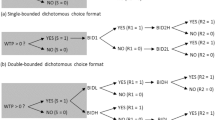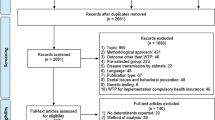Abstract
We examine starting point bias in double-bounded dichotomous choice contingent valuation surveys. We investigate (1) the seriousness of the biases for the location and scale parameters of the willingness-to-pay (WTP) in the presence of starting point bias; (2) whether or not these biases depend on the distribution of WTP and on the bid design; and (3) how well a commonly used diagnostic for starting point bias—a test of the null that bid set dummies entered in the right-hand side of the WTP model are jointly equal to zero—performs under various circumstances. Monte Carlo simulations suggest that the effect of ignoring starting point bias depends on the bid design and on the true distribution of WTP. A well-balanced, symmetric bid design may result in very modest biases even when the anchoring mechanism is very strong. The power of bid set dummies in detecting starting point bias is low. They tend to account for misspecifications in the distribution assumed by the researcher for the latent WTP, rather than capturing the presence of starting point bias.
Similar content being viewed by others
Abbreviations
- CV:
-
Contingent valuation
- DB:
-
Double-bounded
- DC:
-
Dichotomous choice
- WTP:
-
Willingness-to-pay
References
Alberini A (1995) Optimal designs for discrete choice contingent valuation surveys: single-bound, double-bound and bivariate models. J Environ Econ Manage 28: 187–306
Alberini A, Kanninen B, Carson RT (1997) Modeling response incentive effects in dichotomous choice contingent valuation data. Land Econ 73(3): 309–324
Alberini A, Longo A, Veronesi M (2006) Basic statistical models for conjoint choice experiments. In: Kanninen B (ed) Valuing environmental amenities using choice experiments: a common sense guide to theory and practice, chap 8. Springer, Dordrecht, pp 203–227
Aprahamian F, Chanel O, Luchini S (2007) Modeling starting point bias as unobserved heterogeneity in contingent valuation surveys: an application to air pollution. Am J Agric Econ 89(2): 533–547
Aprahamian F, Chanel O, Luchini S (2008) Heterogeneous anchoring and the shift effect in iterative valuation questions. Resour Energy Econ 30: 12–20
Arana JE, Leon CJ (2008) Do emotions matter? coherent preferences under anchoring and emotional effects. Ecol Econ 66(4): 700–711
Ariely D, Loewenstein G, Prelec D (2003) Coherent arbitrariness: stable demand curves without stable preferences. Q J Econ 118: 73–105
Baiocchi G (2005) Monte Carlo methods in environmental economics. In: Scarpa R, Alberini A (eds) Applications of simulation methods in environmental and resource economics, chap 16. Springer, Dordrecht, pp 317–340
Bateman IJ, Carson RT, Day B, Hanemann M, Hanley N, Hett T, Jones-Lee M, Loomes G, Mourato S, Ozdemiroglu E, Pearce DW, Sugden R, Swanson J (2002) Economic valuation with stated preference techniques: a manual. Edward Elgar, Cheltenham
Bergman O, Ellingsen T, Johannesson M, Svensson C (2010) Anchoring and cognitive ability. Econ Lett 107: 66–68
Boyle K, Bishop RC, Welsh MC (1985) Starting point bias in contingent valuation bidding games. Land Econ 61(2): 188–194
Brookshire D, Randall A (1978) Public policy, public goods and contingent valuation mechanisms. Staff Paper 68, Department of Agricultural Economics, University of Kentucky
Cameron TA, Quiggin J (1994) Estimation using contingent valuation data form a ‘Dichotomous Choice with Follow-up’ questionnaire. J Environ Econ Manage 15(3): 355–379
Chien Y, Huang CJ, Shaw D (2005) A general model of starting point bias in double-bounded dichotomous choice contingent valuation surveys. J Environ Econ Manage 50: 362–377
Cooper JC (1993) Optimal bid selection for dichotomous choice contingent valuation surveys. J Environ Econ Manage 24(1): 25–40
Cooper JC (2002) Flexible functional form estimation of willingness to pay using dichotomous choice data. J Environ Econ Manage 43(2): 267–279
Crooker JR, Herriges JA (2004) Parametric and semi-nonparametric estimation of willingness-to-pay in the dichotomous choice contingent valuation framework. Environ Resour Econ 27: 451–480
Czajkowski JR (2009) Modeling shifts in willingness to pay from a bayesian updating perspective. Land Econ 85(2): 308–328
DeShazo JR (2002) Designing transactions without framing effects in iterative question formats. J Environ Econ Manage 43: 360–385
Flachaire E, Hollard G (2006) Controlling starting-point bias in double-bounded contingent valuation surveys. Land Econ 82(1): 103–111
Flachaire E, Hollard G (2007) Starting-point bias and respondent uncertainty in dichotomous choice contingent valuation surveys. Resour Energy Econ 29: 183–194
Green D, Jacowitz KE, Kahneman D, Mcfadden D (1998) Referendum contingent valuation, anchoring, and willingness to pay for public goods. Resour Energy Econ 20: 85–116
Hanemann M, Loomis J, Kanninen B (1991) Statistical efficiency of double-bounded dichotomous choice contingent valuation. Am J Agric Econ 73(4): 255–263
Hausman, JA (ed) (1993) Contingent valuation: a critical assessment. North-Holland, Amsterdam
Herriges JA, Shogren JF (1996) Starting point bias in dichotomous choice valuation with follow-up questioning. J Environ Econ Manage 30: 112–131
Huang J-C, Nychka DW, Smith VK (2008) Semi-parametric discrete choice measures of willingness to pay. Econ Lett 101(1): 91–94
Kanninen B (1991) Optimal experimental design for contingent valuation surveys. Unpublished PhD dissertation, UC Berkeley
Lechner S, Rozan A, Francois L (2003) A model of anchoring effect in dichotomous choice valuation with follow-up. Working paper of BETA 2003–2007, Bureau d’Economie Théorique et Appliquée, ULP, Strasbourg
Leon R, Leon CJ (2003) Single or double bounded contingent valuation? A bayesian test. Scott J Polit Econ 50(2): 174–188
Mitchell RC, Carson RT (1989) Using surveys to value public goods: the contingent valuation method. Johns Hopkins University Press, Baltimore
Tversky A, Kahneman D (1974) Judgment under uncertainty: heuristics and biases. Science 185: 1124–1131
Watanabe M (2010) Nonparametric estimation of mean willingness to pay from discrete response valuation data. Am J Agric Econ 92(4): 1114–1135
Whitehead JC (2002) Incentive incompatibility and starting-point bias in iterative valuation questions. Land Econ 78(2): 285–297
Whitehead JC (2004) Incentive incompatibility and starting-point bias in iterative valuation questions: reply. Land Econ 80(2): 316–319
Whittington D, Briscoe J, Mu X, Barron W (1990) Estimating the willingness to pay for water services in developing countries: a case study of the use of contingent valuation surveys in Southern Haiti. Econ Dev Cultural Change 38(2): 293–311
Wilson T, Houston C, Etling K, Brekke N (1996) A new look at anchoring effects: basic anchoring and its antecedents. J Exp Psychol Gen 125: 387–402
Author information
Authors and Affiliations
Corresponding author
Additional information
The views expressed are the authors’ and do not necessarily represent policies or views of their respective institutions.
Rights and permissions
About this article
Cite this article
Veronesi, M., Alberini, A. & Cooper, J.C. Implications of Bid Design and Willingness-To-Pay Distribution for Starting Point Bias in Double-Bounded Dichotomous Choice Contingent Valuation Surveys. Environ Resource Econ 49, 199–215 (2011). https://doi.org/10.1007/s10640-010-9430-1
Accepted:
Published:
Issue Date:
DOI: https://doi.org/10.1007/s10640-010-9430-1




